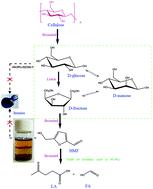当前位置:
X-MOL 学术
›
Green Chem.
›
论文详情
Our official English website, www.x-mol.net, welcomes your
feedback! (Note: you will need to create a separate account there.)
Efficient catalytic conversion of cellulose to levulinic acid in the biphasic system of molten salt hydrate and methyl isobutyl ketone
Green Chemistry ( IF 9.3 ) Pub Date : 2020-05-20 , DOI: 10.1039/d0gc00897d Jinghua Wang 1, 2, 3, 4 , Hongyou Cui 1, 2, 3, 4 , Yong Wang 1, 2, 3, 4 , Rongrong Zhao 1, 2, 3, 4 , Yujiao Xie 1, 2, 3, 4 , Ming Wang 1, 2, 3, 4 , Weiming Yi 2, 3, 4, 5
Green Chemistry ( IF 9.3 ) Pub Date : 2020-05-20 , DOI: 10.1039/d0gc00897d Jinghua Wang 1, 2, 3, 4 , Hongyou Cui 1, 2, 3, 4 , Yong Wang 1, 2, 3, 4 , Rongrong Zhao 1, 2, 3, 4 , Yujiao Xie 1, 2, 3, 4 , Ming Wang 1, 2, 3, 4 , Weiming Yi 2, 3, 4, 5
Affiliation

|
An efficient approach for the synthesis of levulinic acid (LA) by converting cellulose in a biphasic system consisting of molten salt hydrate (MSH), (LiCl·3H2O) and methyl isobutyl ketone (MIBK) using NbOPO4/HZSM-5 as the catalyst was reported. A series of molten salt hydrates (LiBr·3H2O, LiCl·3H2O, ZnCl2·3H2O, CaCl2·3H2O and Ca(NO3)2·3H2O) were evaluated in terms of their cellulose dissolvability and catalytic activity without any additional catalyst in the conversion of cellulose to LA. Among them, LiBr·3H2O, LiCl·3H2O and ZnCl2·3H2O were capable of dissolving and swelling cellulose and demonstrated excellent performance in cellulose conversion to LA even without any additional catalyst. High temperature favors the formation of LA while low temperature is beneficial to saccharides and 5-hydroxymethylfurfural (HMF). Using NbOPO4/HZSM-5, an efficient conversion of cellulose to LA was achieved in a biphasic system, affording a LA yield as high as 94.0%. The partition coefficient of HMF between the MIBK and LiCl·3H2O phases increased notably when the temperature was increased, proving that a biphasic solvent restrained the secondary reaction of HMF to humins. The reaction mechanism study based on the investigation of converting glucose, fructose and HMF to LA found that the side reactions of saccharides to humins are the key factors affecting the selectivity of LA in the investigated reaction system. Therefore, it is crucial to match the cellulose hydrolysis reaction with the subsequent reactions to maintain saccharides including glucose and fructose at low concentrations for highly efficient conversion of cellulose to LA.
中文翻译:

在熔融盐水合物和甲基异丁基酮的双相体系中,纤维素高效催化转化为乙酰丙酸
通过将纤维素在由熔融盐水合物(MSH),(LiCl·3H 2 O)和甲基异丁基酮(MIBK)组成的两相系统中使用NbOPO 4 / HZSM-5作为转化体系来合成乙酰丙酸(LA)的有效方法报告了催化剂。就它们的一系列熔融盐水合物(LiBr·3H 2 O,LiCl·3H 2 O,ZnCl 2 ·3H 2 O,CaCl 2 ·3H 2 O和Ca(NO 3)2 ·3H 2 O)进行了评估。纤维素的溶解性和催化活性,无需任何其他催化剂即可将纤维素转化为LA。其中,LiBr·3H 2 O,LiCl·3H2 O和ZnCl 2 ·3H 2 O能够溶解和溶胀纤维素,并且即使不添加任何催化剂也表现出优异的纤维素转化为LA的性能。高温有利于LA的形成,而低温有利于糖和5-羟甲基糠醛(HMF)。使用NbOPO 4 / HZSM-5,在双相系统中实现了纤维素向LA的有效转化,提供了高达94.0%的LA收率。HMF在MIBK和LiCl·3H 2之间的分配系数当温度升高时,O相显着增加,证明了两相溶剂抑制了HMF与腐殖质的二次反应。在研究葡萄糖,果糖和HMF转化为LA的反应机理研究中,发现糖类转化为腐殖质的副反应是影响LA在反应体系中选择性的关键因素。因此,至关重要的是使纤维素水解反应与随后的反应相匹配,以将包括葡萄糖和果糖在内的糖类保持在低浓度,以使纤维素高效转化为LA。
更新日期:2020-07-06
中文翻译:

在熔融盐水合物和甲基异丁基酮的双相体系中,纤维素高效催化转化为乙酰丙酸
通过将纤维素在由熔融盐水合物(MSH),(LiCl·3H 2 O)和甲基异丁基酮(MIBK)组成的两相系统中使用NbOPO 4 / HZSM-5作为转化体系来合成乙酰丙酸(LA)的有效方法报告了催化剂。就它们的一系列熔融盐水合物(LiBr·3H 2 O,LiCl·3H 2 O,ZnCl 2 ·3H 2 O,CaCl 2 ·3H 2 O和Ca(NO 3)2 ·3H 2 O)进行了评估。纤维素的溶解性和催化活性,无需任何其他催化剂即可将纤维素转化为LA。其中,LiBr·3H 2 O,LiCl·3H2 O和ZnCl 2 ·3H 2 O能够溶解和溶胀纤维素,并且即使不添加任何催化剂也表现出优异的纤维素转化为LA的性能。高温有利于LA的形成,而低温有利于糖和5-羟甲基糠醛(HMF)。使用NbOPO 4 / HZSM-5,在双相系统中实现了纤维素向LA的有效转化,提供了高达94.0%的LA收率。HMF在MIBK和LiCl·3H 2之间的分配系数当温度升高时,O相显着增加,证明了两相溶剂抑制了HMF与腐殖质的二次反应。在研究葡萄糖,果糖和HMF转化为LA的反应机理研究中,发现糖类转化为腐殖质的副反应是影响LA在反应体系中选择性的关键因素。因此,至关重要的是使纤维素水解反应与随后的反应相匹配,以将包括葡萄糖和果糖在内的糖类保持在低浓度,以使纤维素高效转化为LA。











































 京公网安备 11010802027423号
京公网安备 11010802027423号